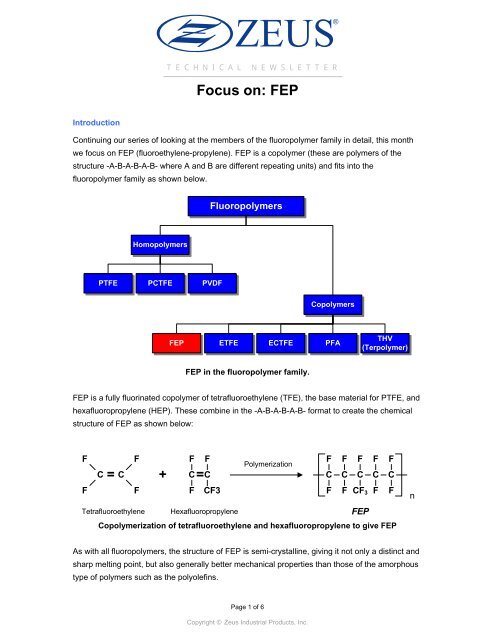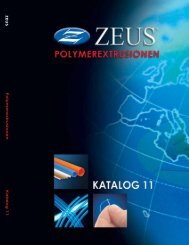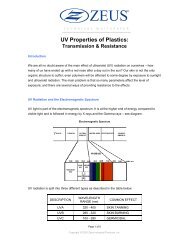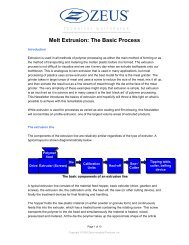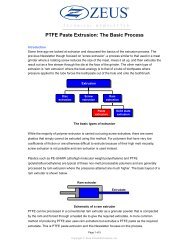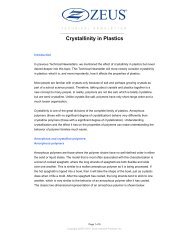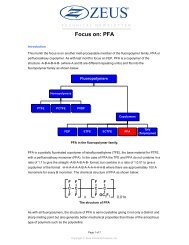Focus on: FEP - Zeus Industrial Products, Inc.
Focus on: FEP - Zeus Industrial Products, Inc.
Focus on: FEP - Zeus Industrial Products, Inc.
You also want an ePaper? Increase the reach of your titles
YUMPU automatically turns print PDFs into web optimized ePapers that Google loves.
Introducti<strong>on</strong><br />
TECHNICAL NEWSLETTER<br />
<str<strong>on</strong>g>Focus</str<strong>on</strong>g> <strong>on</strong>: <strong>FEP</strong><br />
C<strong>on</strong>tinuing our series of looking at the members of the fluoropolymer family in detail, this m<strong>on</strong>th<br />
we focus <strong>on</strong> <strong>FEP</strong> (fluoroethylene-propylene). <strong>FEP</strong> is a copolymer (these are polymers of the<br />
structure -A-B-A-B-A-B- where A and B are different repeating units) and fits into the<br />
fluoropolymer family as shown below.<br />
Homopolymers<br />
PTFE PCTFE PVDF<br />
Fluoropolymers<br />
Page 1 of 6<br />
Copyright © <strong>Zeus</strong> <strong>Industrial</strong> <strong>Products</strong>, <strong>Inc</strong>.<br />
Copolymers<br />
<strong>FEP</strong> ETFE ECTFE PFA<br />
<strong>FEP</strong> in the fluoropolymer family.<br />
THV<br />
(Terpolymer)<br />
<strong>FEP</strong> is a fully fluorinated copolymer of tetrafluoroethylene (TFE), the base material for PTFE, and<br />
hexafluoropropylene (HEP). These combine in the -A-B-A-B-A-B- format to create the chemical<br />
structure of <strong>FEP</strong> as shown below:<br />
F<br />
F<br />
C<br />
=<br />
C<br />
F<br />
F<br />
+<br />
F F<br />
C=<br />
C<br />
Polymerizati<strong>on</strong><br />
F<br />
C<br />
F<br />
C<br />
F<br />
C<br />
F<br />
C<br />
F CF3<br />
F F CF3 F<br />
Tetrafluoroethylene Hexafluoropropylene<br />
<strong>FEP</strong><br />
Copolymerizati<strong>on</strong> of tetrafluoroethylene and hexafluoropropylene to give <strong>FEP</strong><br />
As with all fluoropolymers, the structure of <strong>FEP</strong> is semi-crystalline, giving it not <strong>on</strong>ly a distinct and<br />
sharp melting point, but also generally better mechanical properties than those of the amorphous<br />
type of polymers such as the polyolefins.<br />
F<br />
C<br />
F<br />
n
<strong>FEP</strong> was first produced by DuP<strong>on</strong>t in 1956 as Tefl<strong>on</strong> � <strong>FEP</strong> and was the first commercially<br />
produced material to combine the unique mechanical and chemical properties of the<br />
fluoropolymers with the melt-processability of more c<strong>on</strong>venti<strong>on</strong>al polymers. Inevitably, the search<br />
for melt-processability required some minor trade-offs in mechanical and physical properties, and<br />
while <strong>FEP</strong> is superior to PTFE in some properties (i.e. impact strength), the general mechanical<br />
and chemical properties of <strong>FEP</strong> are very similar to those of PTFE. The major difference is that the<br />
maximum service temperature for <strong>FEP</strong> is 205 o C and this is about 60 o C lower than that of PTFE.<br />
Properties<br />
The general properties of <strong>FEP</strong> are typical of other semi-crystalline high performance<br />
thermoplastics:<br />
� Very good temperature stability<br />
� Outstanding electrical properties<br />
� Outstanding chemical resistance<br />
� Outstanding weathering resistance<br />
� Low coefficient of fricti<strong>on</strong><br />
� Excellent toughness but generally low mechanical strength<br />
� High cost<br />
Physical and Mechanical<br />
The physical and mechanical properties of <strong>FEP</strong> are broadly comparable to those of PTFE.<br />
However, the temperature of use is restricted to a smaller range (-240°C to +205°C) and some<br />
mechanical properties (such as cut through and abrasi<strong>on</strong> resistance) are less than PTFE.<br />
Typical mechanical and thermal properties are given in the table below.<br />
Property<br />
Page 2 of 6<br />
Approximate Value<br />
Natural polymer<br />
Tensile Strength (@23 o C) 14 – 20 MPa<br />
Tensile Modulus (@ 1% strain @ 23 o C) 0.6 GPa<br />
El<strong>on</strong>gati<strong>on</strong> at Break (@23 o C) 300%<br />
Flexural Strength (@23 o C) No Break<br />
Izod Notched Impact Strength (@23 o C) No Break<br />
Coefficient of fricti<strong>on</strong> (dynamic) 0.25<br />
Heat Deflecti<strong>on</strong> Temperature (0.45 MPa) 60 o C<br />
Low Temperature Toughness –240 o C<br />
Coefficient of Thermal Expansi<strong>on</strong> (20 – 100 o C) 5 x 10 -5 / o C<br />
Copyright © <strong>Zeus</strong> <strong>Industrial</strong> <strong>Products</strong>, <strong>Inc</strong>.
L<strong>on</strong>g Term Service Temperature 205 o C<br />
Melting point 260 o C - 270 o C<br />
Specific Gravity 2.1 – 2.2<br />
Water Absorpti<strong>on</strong> 0.004 – 0.01% (50% rh)<br />
Appearance Transparent<br />
Thermal and Flammability<br />
<strong>FEP</strong> is also <strong>on</strong>e of the few plastics that is both suitable for high and low temperature applicati<strong>on</strong>s<br />
and can be used over the range of temperatures –240 o C to 205 o C. This is <strong>on</strong>ly slightly less than<br />
the working temperature range of PTFE, but <strong>FEP</strong> has the advantage of being melt-processable.<br />
The fire behavior of <strong>FEP</strong> is also excellent and has no difficulty in achieving UL 94 V-0 for flame<br />
resistance. The Limiting Oxygen Index (LOI) for <strong>FEP</strong> is greater than 95, which means that there<br />
must be over 95% oxygen present to support free combusti<strong>on</strong> (air <strong>on</strong>ly c<strong>on</strong>tains approximately<br />
21% oxygen and therefore a material with a LOI of greater than 21 will probably not support<br />
burning in an open air situati<strong>on</strong>).<br />
Even when <strong>FEP</strong> does burn, the heat of combusti<strong>on</strong> is extremely low, the amount of smoke<br />
released is minimal, and the decompositi<strong>on</strong> gases have very low corrosiveness, therefore<br />
minimizing the major factors in the damage caused by real fires with cable and building related<br />
products.<br />
Electrical<br />
<strong>FEP</strong> has excellent dielectric properties at high frequencies and both the dielectric c<strong>on</strong>stant and<br />
the dielectric loss tangent are low over a wide range. These properties make <strong>FEP</strong> an ideal<br />
material for insulating high-speed data transmissi<strong>on</strong> cables (such as Cat 5 and Cat 6 LAN cables).<br />
Chemical Resistance<br />
The fully fluorinated structure of <strong>FEP</strong> gives it a chemical resistance similar to that of PTFE and<br />
makes it suitable for applicati<strong>on</strong>s in aggressive chemical envir<strong>on</strong>ments at temperatures up to<br />
205 o C. This is particularly true for envir<strong>on</strong>ments where mixed acids and solvents are present.<br />
<strong>FEP</strong> is resistant to virtually all chemicals, except molten alkali metals, fluorine (as a gas) and<br />
some other halogen complexes.<br />
<strong>FEP</strong> is suitable for food c<strong>on</strong>tact and is FDA compliant for safe use (21CFR.17.1550). This is<br />
especially true for film grades, which c<strong>on</strong>tain no plasticizers or other additives, and have very low<br />
permeability to liquids, gases and moisture.<br />
Page 3 of 6<br />
Copyright © <strong>Zeus</strong> <strong>Industrial</strong> <strong>Products</strong>, <strong>Inc</strong>.
<strong>FEP</strong> is also suitable for medical applicati<strong>on</strong>s. It is biocompatible to USP Class VI (n<strong>on</strong>-toxic, n<strong>on</strong>hemolytic<br />
and n<strong>on</strong>-pyrogenic), and <strong>FEP</strong> products can be sterilized by gamma, EtO, e-beam, or<br />
autoclaving.<br />
<strong>FEP</strong> has good weathering resistance to sunlight, oz<strong>on</strong>e and general weathering, and weathering<br />
tests in Florida show no measurable property changes even after 20 years.<br />
Optical<br />
<strong>FEP</strong> has a high transparency with good transmittance of both UV and visible wavelengths. <strong>FEP</strong><br />
also has the lowest refractive index of all polymers (1.338) and films made from <strong>FEP</strong> are<br />
extremely clear and transparent.<br />
<strong>FEP</strong> can be pigmented almost any color but <strong>on</strong>ly inorganic pigments can be used due to the high<br />
processing temperatures required for <strong>FEP</strong>.<br />
Advantages and Limitati<strong>on</strong>s<br />
Advantages Limitati<strong>on</strong>s<br />
Melt-processable fluoropolymer Higher cost in relati<strong>on</strong> to some other<br />
polymers<br />
Very good high and low temperature<br />
performance for all mechanical properties<br />
Excellent electrical performance at high<br />
temperatures<br />
Excellent chemical resistance over a wide<br />
range of temperatures<br />
High transparency with good transmittance of<br />
both UV and visible wavelengths and a very<br />
low refractive index (1.34)<br />
Page 4 of 6<br />
Copyright © <strong>Zeus</strong> <strong>Industrial</strong> <strong>Products</strong>, <strong>Inc</strong>.<br />
Low cut through and abrasi<strong>on</strong> resistance<br />
in the natural state<br />
Lower maximum service temperature<br />
than PTFE<br />
Softer in relati<strong>on</strong> to some other polymers<br />
Processing requires specially treated<br />
equipment to avoid corrosi<strong>on</strong> of<br />
equipment<br />
Very low coefficient of fricti<strong>on</strong> Processing requires suitable machines to<br />
cope with high melt viscosity<br />
Processing<br />
As a melt-processable material, <strong>FEP</strong> can be processed by most of the traditi<strong>on</strong>al plastics<br />
processing methods. The material is used extensively for injecti<strong>on</strong> molding, extrusi<strong>on</strong>, coating,<br />
and impregnating of fabrics and metals. Whichever processing method is used, the processing<br />
machinery must be suitable for use at the high processing temperatures and high melt viscosities<br />
required to process <strong>FEP</strong>. Molten <strong>FEP</strong> is also corrosive to many metals and corrosi<strong>on</strong> resistant
materials should be used for all parts of the machinery likely to come into c<strong>on</strong>tact with the molten<br />
material (i.e. nickel based alloys).<br />
Processing Method Applicable<br />
Injecti<strong>on</strong> molding Yes<br />
Extrusi<strong>on</strong> (profiles, films, sheet, tubing, heat shrink tubing, and cable<br />
coating)<br />
Blow molding Yes<br />
Compressi<strong>on</strong> molding Yes<br />
Impregnati<strong>on</strong> and coating Yes<br />
<strong>FEP</strong> Grades<br />
<strong>FEP</strong> is produced in a variety of grades depending <strong>on</strong> the processing method to be used for the<br />
material. Specific grades are available for injecti<strong>on</strong> molding, extrusi<strong>on</strong>, blow molding, cable<br />
coating, fabric impregnati<strong>on</strong> (as aqueous dispersi<strong>on</strong>s), and even foamed cable insulati<strong>on</strong>.<br />
Finishing<br />
<strong>FEP</strong> is available as semi-finished products in rod, tube, sheet and other formats suitable for<br />
further machining. These products can be machined using c<strong>on</strong>venti<strong>on</strong>al machine tools to give an<br />
excellent finish for prototype evaluati<strong>on</strong> or small run producti<strong>on</strong>. <strong>FEP</strong> machines easily and<br />
accurately using c<strong>on</strong>venti<strong>on</strong>al machine tools with carbide or diam<strong>on</strong>d tipped tooling. Speeds and<br />
feeds should be slow (as with any plastic material) to prevent excessive heat build up in the part.<br />
<strong>FEP</strong> can also be provided as a transparent film that can be heat sealed, vacuum formed,<br />
laminated, thermoformed and even used as a hot-melt adhesive.<br />
Typical Applicati<strong>on</strong>s<br />
The combinati<strong>on</strong> of many of the unique properties of PTFE with melt-processability allows <strong>FEP</strong> to<br />
be used in a wide range of applicati<strong>on</strong>s where high temperature stability, chemical resistance and<br />
low coefficient of fricti<strong>on</strong> make it the ideal material despite the higher cost. Typical applicati<strong>on</strong>s<br />
include:<br />
� Semic<strong>on</strong>ductor and pharmaceutical industries-due to excellent chemical resistance and low<br />
extractables (high purity)<br />
� Protective linings for piping and tubing<br />
� Wire and cable insulati<strong>on</strong> for computers and electr<strong>on</strong>ics systems<br />
� Wire and cable insulati<strong>on</strong> for high-speed data transmissi<strong>on</strong> cables (such as Cat 5 and Cat 6<br />
LAN cables) – the low coefficient of fricti<strong>on</strong> also means that cables are very easy to lay and<br />
replace in buildings<br />
Page 5 of 6<br />
Copyright © <strong>Zeus</strong> <strong>Industrial</strong> <strong>Products</strong>, <strong>Inc</strong>.<br />
Yes
� Films for release surfaces<br />
� Roll covers<br />
� Glazing film for solar energy collectors<br />
� Envir<strong>on</strong>mental m<strong>on</strong>itoring equipment<br />
� Thermal c<strong>on</strong>trol materials (as used <strong>on</strong> the Hubble Space Telescope)<br />
Summary<br />
At its discovery <strong>FEP</strong> represented a major step in commercializing the fluoropolymers and in<br />
extending the applicati<strong>on</strong>s for this remarkable family of materials. The melt-processability of <strong>FEP</strong><br />
meant that the traditi<strong>on</strong>al plastics processing methods could be used to process fluoropolymers –<br />
fluoropolymers had left the ‘developmental’ and ‘interesting’ stage and had joined the ranks of the<br />
traditi<strong>on</strong>al polymers. Even compared to more recently developed fluoropolymers, <strong>FEP</strong> remains<br />
the best material for applicati<strong>on</strong>s requiring excellent electrical or barrier properties and is a<br />
valuable additi<strong>on</strong> to the fluoropolymer family.<br />
How <strong>Zeus</strong> Can Help<br />
With a technical inside and outside sales force backed up with engineering and polymer experts,<br />
<strong>Zeus</strong> is prepared to assist in material selecti<strong>on</strong> and can provide product samples for evaluati<strong>on</strong>. A<br />
dedicated R&D department staffed with PHD Polymer chemists and backed with the support of a<br />
world-class analytical lab allows <strong>Zeus</strong> an unparalleled positi<strong>on</strong> in polymer development and<br />
customizati<strong>on</strong>.<br />
<strong>Zeus</strong> was built up<strong>on</strong> the core technology of precisi<strong>on</strong> extrusi<strong>on</strong> of high temperature plastics.<br />
Today, with a broad portfolio of engineered resins and sec<strong>on</strong>dary operati<strong>on</strong>s, <strong>Zeus</strong> can provide<br />
turnkey soluti<strong>on</strong>s for development and high-volume supply requirements.<br />
C<strong>on</strong>tact Us<br />
Additi<strong>on</strong>al technical support is available by c<strong>on</strong>tacting a <strong>Zeus</strong> technical account manager at:<br />
Toll-Free in US (800) 526-3842 or Internati<strong>on</strong>al (803) 268-9500. Email us at editor@zeusinc.com.<br />
3737 <strong>Industrial</strong> Blvd.<br />
Orangeburg, SC 29118 United States<br />
<strong>Zeus</strong> Ireland - Tel +353-74-9109700<br />
<strong>Zeus</strong> China - 电话 +(86)20-38791260<br />
Page 6 of 6<br />
Copyright © <strong>Zeus</strong> <strong>Industrial</strong> <strong>Products</strong>, <strong>Inc</strong>.


